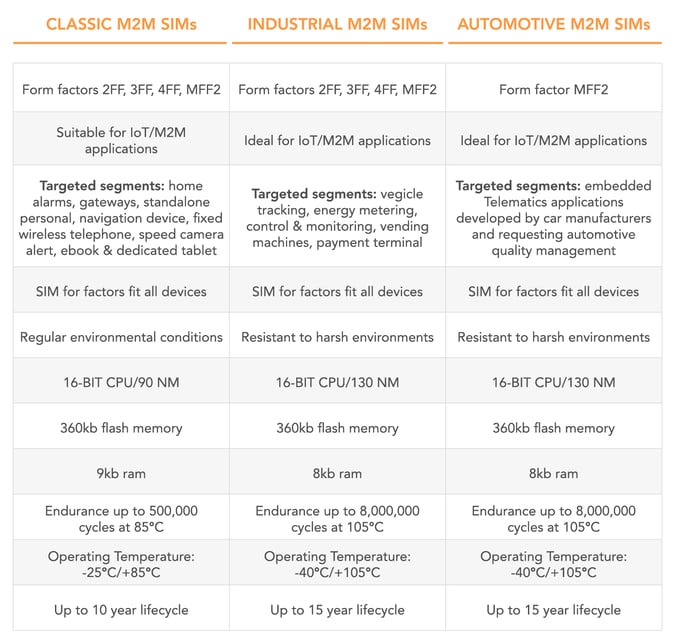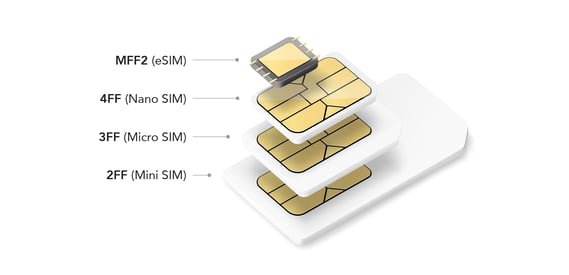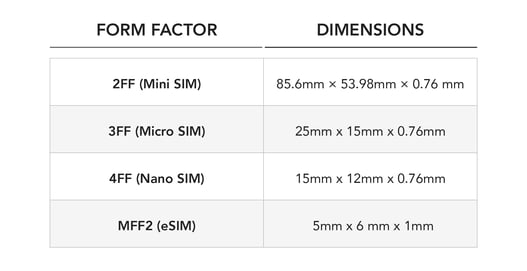

Quick definition: M2M SIM stands for Machine-to-Machine Subscriber Identity Module. It’s the technology that enables devices and sensors (the “things” within the Internet of Things) to communicate with other internet-enabled devices and systems.
M2M SIMs connect IoT applications to cellular networks, where they can use an interchangeable protocol to send and receive data. IoT manufacturers can either insert or embed M2M SIMs in their devices, and companies can remotely collect and analyze usage data from the SIM.
M2M SIMs come in the same sizes as traditional SIMs, but unlike traditional SIMs, they have specialized features for IoT applications.
There are a few key concepts to understand about M2M SIMs, including:
- How they compare to traditional SIMs
- Industrial and automotive M2M SIMs
- SIM application toolkits
- M2M SIM form factors
- The benefits of using one
For starters, let’s look at how they compare to the SIMs you’ll find in cell phones.
Classic SIMs vs. M2M SIMs
M2M SIMs come in more durable forms than you’ll find in classic consumer SIMs, which are designed for cell phones. Although these traditional SIMs work in M2M or IoT devices, they’re designed for normal, everyday use and may not hold up in harsher operating environments.
More importantly, they’re built to accommodate how we use cell phones, which isn’t how most M2M devices operate. Traditional SIMs come with rigid contract terms, fixed data plans, and high roaming charges. They’re also difficult to access and manage remotely.
Both classic consumer and M2M SIMs come in several form factors, including 2FF, 3FF, and 4FF, as well as MFF2 (also known as embedded SIMs). Automotive M2M SIMs come only in the MFF2 “embedded” form factor.
At the end of the day, M2M SIMs are designed for usage in a broad range of IoT applications—and classic SIMs are designed for use in cell phones.
Industrial and automotive M2M SIMs
Industrial IoT and automotive M2M applications are a lot more demanding than consumer cell phone applications. M2M SIMs have to be more durable. So they’re built differently.
M2M SIMs are made of materials that enable them to operate in harsh environments with extreme temperatures and vibrations, such as deserts, arctic climates, and moving vehicles. The typical operating temperature range of M2M SIMs is -25°C to 85°C, while more durable variants designed for industrial and automotive use can withstand temperatures ranging from -40°C to 105°C.
They also typically have greater storage capacity and longer lifetimes than classic SIMs.
These stronger SIMs can be used for automotive applications, remote sensors, and other devices that need to remain operational and long-lasting in harsh environments. Use cases that require SIM durability beyond that of standard M2M SIMs may have operational needs such as:
- Extended temperature range from -40°C to 105°C (extreme heat or cold scenarios)
- High resistance against corrosion, vibration, and shock thanks to embedded SIMs
- Longer life expectancy and data retention (10+ years)
The ability to survive in harsh environmental conditions, maintain data for a longer period of time, and extended life expectancy makes industrial and automotive M2M SIMs a perfect match for their respective IoT use cases. On top of that, the longer lifespan compared to standard SIMs means you can save on the cost of replacement over the long term.
You can find a more detailed explanation on SIM form factors and which SIM works best for your business needs in this blog post.
What is a SIM application toolkit?
The SIM application toolkit (STK) consists of a set of commands programmed into the SIM, which allows you to run applications on the SIM. This defines how the SIM interacts with the outside world and initiates commands independently of the device and the network operator. It enables you to control the device’s interface and creates an interaction between the network application and end user.
Why is STK important?
An M2M SIM is only as useful as the STK that it is programmed with. EMnify’s SIMs have a specially installed applet that enables you to enjoy the best selection of available mobile networks through the SIM’s lifespan. EMnify’s STK will continuously update the SIM over-the-air to assign the best mobile network operator.
M2M SIM form factors
“Form factors” refer to the SIM card’s physical size. M2M SIMs come in all the same form factors as traditional SIMs. For IoT manufacturers, it’s important to choose a SIM form factor with the right features for your use case.
SIM cards come in three standard forms: 2FF, 3FF, and 4FF—plus an embedded SIM option, MFF2. (MFF2 stands for “M2M form factor.”) The type and size you select depends on the size and location of your device. To make the best decision for your business, it's crucial to understand your options.
Here’s a simple comparison of how various kinds of SIMs and form factors are used in the Internet of Things.

To compare their sizes, here’s what each of the form factors looks like side-by-side, along with their dimensions.

 But if you’re trying to choose the right SIM card for your application, the form factor isn’t the only thing you need to think about. The company behind your M2M SIM cards can significantly impact what your devices are ultimately capable of, and how much end users can rely on them.
But if you’re trying to choose the right SIM card for your application, the form factor isn’t the only thing you need to think about. The company behind your M2M SIM cards can significantly impact what your devices are ultimately capable of, and how much end users can rely on them.
Benefits of the emnify M2M SIM
emnify’s M2M SIMs are at the heart of our IoT connectivity platform.
Talk to one of our IoT experts. We’ll help you explore the benefits and differences of each SIM option, so you can choose the best one for your business.
And for more on this topic, check out our article about the difference between M2M and IoT.
Get in touch with our IoT experts
Discover how emnify can help you grow your business and talk to one of our IoT consultants today!
.jpg)
Jean-Eudes Ambroise
Director of Customer Success at emnify, Jean-Eudes is an expert in IoT.


